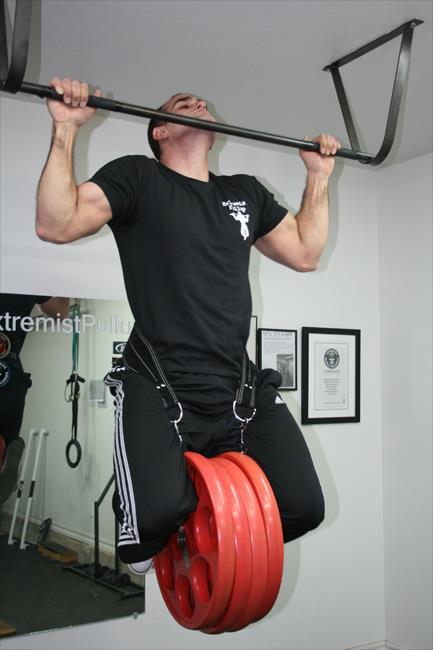I recently learned about a man named Steven Proto who currently holds the Guinness World Record for the world’s heaviest weighted pull-up. I got in touch with him, and asked if I could pick his brain about training. He said, “sure!” So, I sent him a long list of questions, and below, you’ll see what he sent back. But first, a little background info about Steven’s accomplishment from the Guinness World Record’s website…
The heaviest weighted pull up weighed 206.2 lb (93.53 kg) and was achieved by Steven Proto (USA) at a personal gym in Edmond, Oklahoma, USA, on 9 July 2011.
Proto attached four gymnasium weight plates to a belt worn around his waist during the pull up. The plates were tied together with a chain. The entire apparatus was weighed before and immediately after the attempt.
Source: http://www.guinnessworldrecords.com/world-records/12000/heaviest-weighted-pull-up
Here’s a video of the official event…
Steven Proto sets the Guinness World Record for the World’s Heaviest Pull-up
Not too shabby! That is some serious weight. I mean, I’ve done weighted pull-ups – sure. But nothing anywhere near this kind of performance. And even though Steven made it look easy, I’m sure it was anything but easy. To think how much work went into that display of strength, and the fact that the performance only took a few seconds from start to finish… but enough blabbing from me. Onto the interview…
Update: This interview is now only available as part of The Pull-up Solution package here: The Pull-up Solution.

Note: There is detailed information about how and where Steven trains on his website http://www.extremistpullup.com. He also posts videos and information on his athlete Facebook page https://www.facebook.com/ExtremistPullup.
While he is clearly powerful, is he really doing a complete pull-up? I thought the chest should come to the bar and the neck should not go back just so the chin gets to the bar?
P.S. I can’t do 3 unweighted, nor can I do a single chest to the bar pull-up. I’m just trying to maintain your standards. ;-)
Haha, I appreciate the backup, John! But boy, you sure do know how to open a can of lumbricinas with just a few short sentences!
And you bring up a good point – that there are different perspectives on what is considered proper pull-up technique. Also, the context in which we’re training is important, and more specifically, different pull-up techniques serve different purposes and/or have slightly different risks and benefits. With that in mind, it looks like Steven’s pull-up technique is strongly influenced by military PT standards – probably based on what he learned in the USMC. Also, this technique is considered acceptable in a competitive context for testing purposes, when one is trying to score as many reps or with as much weight as possible. The chin’s relation to the bar is merely a traditional coaching protocol that is useful for explaining the exercise, and it’s become somewhat of an official standard.
Now, personally, I’m not one to recommend tilting the head back and breaking neutral spinal alignment during normal, ongoing training because if it becomes a habit, then over time it could lead to neck/spinal/shoulder/etc. problems due to the strain it places on the cervical spine and surrounding areas. Now, if we’re only talking about hyper-extending the neck for the last few repetitions of an official event or test, which happen infrequently (e.g. at the State Fair), then there’s a pretty low risk of injury unless you already have a pre-existing condition. And of course, some people, like Steven, have trained like this for years without a problem anyway.
The underlying point is that all exercises have a risk to benefit ratio and HOW we use them will determine the extent of those risks and benefits (ie results). For instance, if one decides to hyper-extend the neck when doing pullups because it allows them to score a few more reps, then they’re getting better pull-up results, but at a higher risk of injury. It’s a trade-off, and it must be based on a judgment call – hopefully with some objective or even subjective feedback (like using the intuitive training protocol from CST: rating of perceived technique, rating of perceived discomfort, rating of perceived exertion, etc.).
But that’s all geek-speak to most people. And the funny thing is that many people train without thinking of these things and do just fine for decades. But me personally, I’d rather be safe than sorry. I don’t want to be a has-been if and when I hit 40 or 50 years old, and so I make it a point to train as HEALTH-FIRST as possible – even accounting for little details like my head and neck position during pull-ups.
Will it work out someday? Will I be able to train well into old age? Who knows. It’s a lifelong gamble, but I like to think my chances are better because of all the extra attention to detail.
Your mileage may vary ;)
It looks like so much work there. You would think he should be a persoanl trainer or something, not personal banker. But then, it also stands to reason that a person who works a lot on a desk would want to work out well.
great strentgh